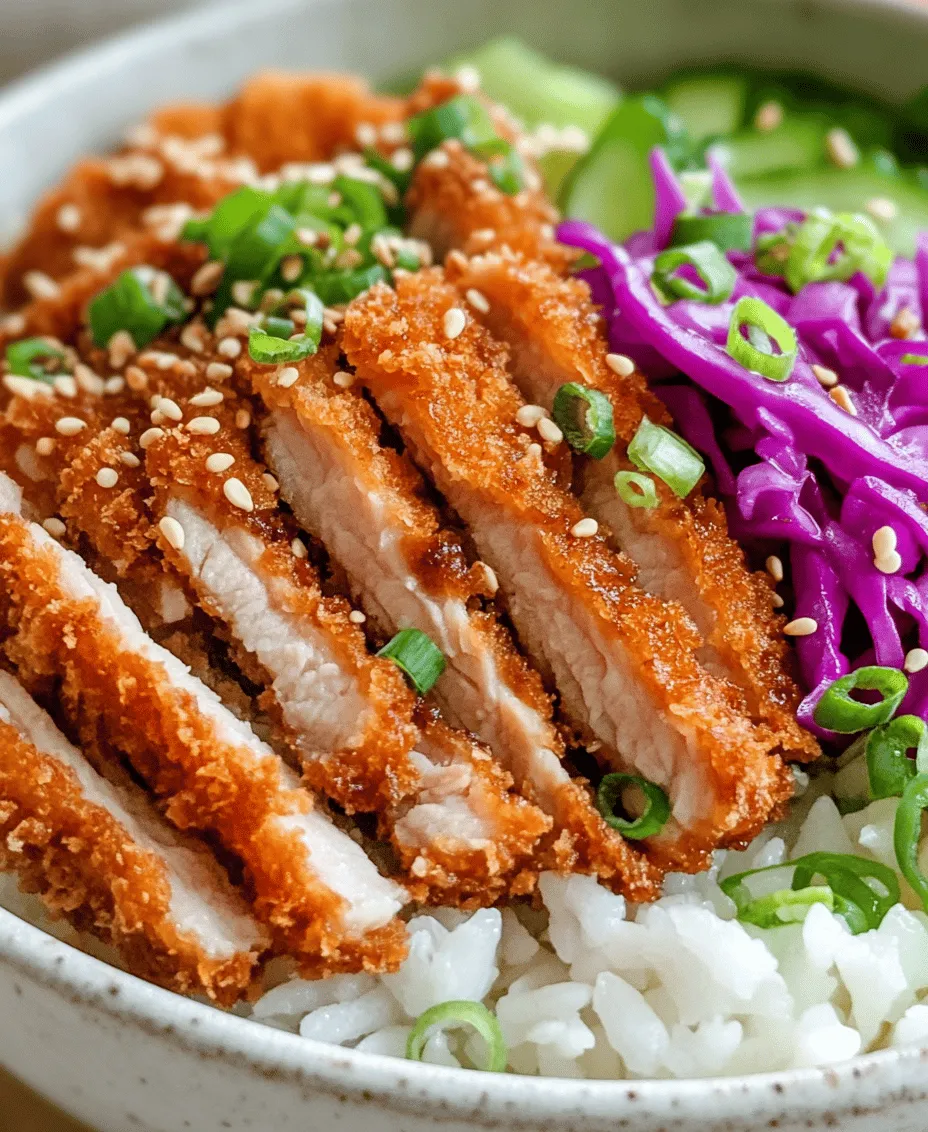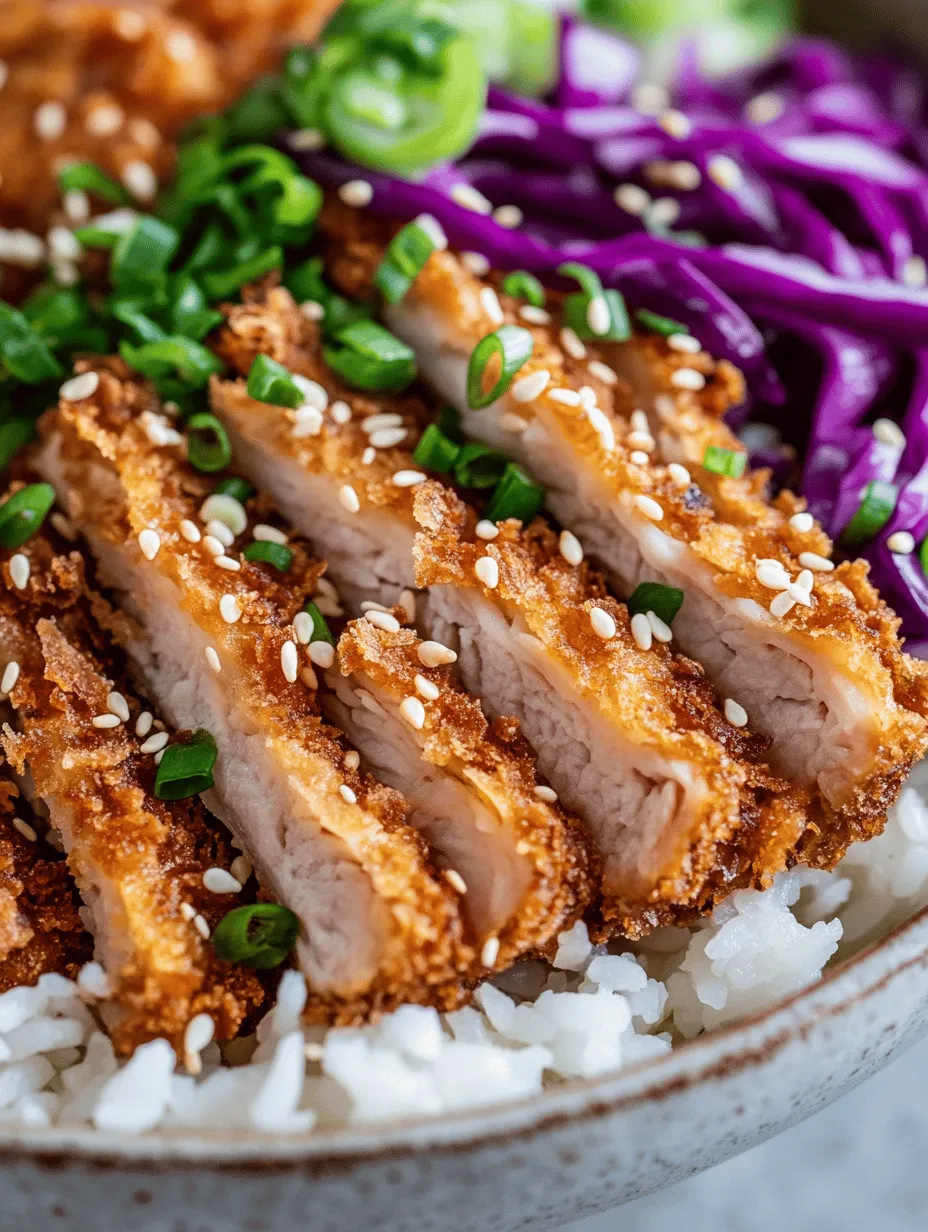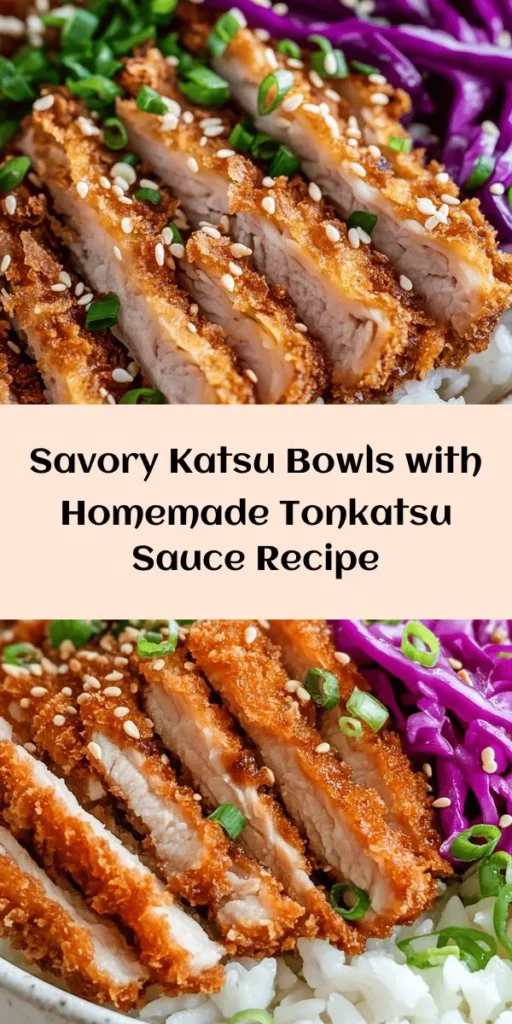Introduction
Katsu bowls are a beloved staple in Japanese cuisine, celebrated for their irresistible combination of flavors and textures. The essence of a Katsu bowl lies in its crispy fried cutlet, served over a bed of fluffy rice and often accompanied by fresh vegetables. This dish is not just a meal; it’s an experience that encapsulates the heart of Japanese culinary traditions. One of the critical components that elevate a Katsu bowl from ordinary to extraordinary is the homemade Tonkatsu sauce, a rich, tangy condiment that perfectly complements the savory notes of the fried cutlet.
In this article, we will delve into the world of Katsu bowls, exploring their cultural significance and providing you with a step-by-step guide to creating your very own Savory Katsu Bowls with Homemade Tonkatsu Sauce. We will start by understanding what Katsu and Tonkatsu sauce are, followed by a detailed look at the ingredients needed for this dish. So, roll up your sleeves, and prepare to embark on a culinary journey that will transport your taste buds to the streets of Japan!
Understanding Katsu and Tonkatsu Sauce
What is Katsu?
Katsu, short for “tonkatsu,” refers to a breaded and deep-fried cutlet, traditionally made from pork. The origins of Katsu can be traced back to the late 19th century during the Meiji era when Western cuisine began to influence Japanese food culture. Katsu quickly gained popularity, evolving from a Western-style dish into a Japanese comfort food staple. Today, it’s common to find various types of Katsu, including chicken (chicken katsu) and fish (fish katsu), but the pork version remains the most iconic.
The preparation of Katsu involves tenderizing the meat, seasoning it, coating it in flour, egg, and panko breadcrumbs, and then frying it until golden brown. This method results in a crunchy exterior and a juicy, flavorful interior. When served in a bowl, Katsu is typically sliced into strips and arranged over rice, often garnished with shredded cabbage and drizzled with Tonkatsu sauce.
What is Tonkatsu Sauce?
Tonkatsu sauce is a thick, tangy condiment that is essential for enhancing the flavors of Katsu. This sauce is often compared to Worcestershire sauce, but it boasts a unique flavor profile that includes sweetness, tanginess, and umami, making it a perfect pairing for fried cutlets. The primary ingredients of Tonkatsu sauce typically include:
– Fruits: Apples or pears are often used to add natural sweetness.
– Vegetables: Onions and carrots contribute to the flavor depth.
– Spices and Seasonings: Soy sauce, vinegar, and a blend of spices create a complex taste.
– Thickening Agents: Some variations may include ketchup or molasses for added thickness and flavor.
The preparation of Tonkatsu sauce is simple yet rewarding. Making it from scratch allows you to customize the flavors to suit your palate, ensuring that every bite of your Katsu bowl is perfectly balanced.
Cultural Significance of Katsu Bowls
Katsu bowls hold a special place in Japanese dining culture. They are often associated with comfort food, enjoyed by families and friends alike. The dish represents a blend of Western influence and traditional Japanese cooking methods, highlighting the country’s ability to adapt and innovate. In Japan, Katsu bowls are frequently served in casual dining settings, from family restaurants to street vendors, making them accessible to everyone.
Beyond their delicious taste, Katsu bowls also symbolize warmth and togetherness, often enjoyed during gatherings or special occasions. The act of sharing a meal featuring Katsu can foster connections and create lasting memories, making it an integral part of Japanese communal dining experiences.
Ingredients Overview
To create the ultimate Savory Katsu Bowls with Homemade Tonkatsu Sauce, you will need a selection of fresh, high-quality ingredients. Below is a detailed description of each component required for the dish:
For the Katsu
– Pork Chops: Bone-in or boneless, pork loin chops are ideal for Katsu. They provide a good amount of meat and fat for flavor. If you prefer a leaner option, chicken breast can also work well.
– Panko Breadcrumbs: Essential for achieving that signature crispy texture. Panko, made from Japanese bread, is coarser than regular breadcrumbs and fries up beautifully.
– Flour: All-purpose flour is used to coat the pork before dipping it in egg, helping the breadcrumbs adhere.
– Eggs: Beaten eggs create a binding layer between the meat and the breadcrumbs.
– Salt and Pepper: Simple seasoning to enhance the flavor of the pork.
For the Tonkatsu Sauce
– Ketchup: Provides sweetness and thickness to the sauce.
– Worcestershire Sauce: Adds a complex umami flavor.
– Soy Sauce: Enhances the salty and savory notes.
– Mirin: This sweet rice wine contributes depth and sweetness.
– Apple Sauce: Fresh or store-bought, this adds a fruity flavor and natural sweetness.
– Mustard: A touch of mustard can add a slight kick to the sauce.
– Garlic and Ginger: Fresh minced garlic and ginger add aromatic flavors.
When preparing your Katsu bowls, it’s essential to use fresh ingredients for optimal flavor. If you have dietary preferences or restrictions, there are various substitutions you can consider. For a gluten-free option, you can use gluten-free breadcrumbs and flour. Additionally, if you want to create a vegan version, you can substitute pork with tofu or eggplant, and use a plant-based egg replacement for the coating.
Making the Tonkatsu Sauce
Now that we have our ingredients ready, let’s dive into making the Tonkatsu sauce, a crucial part of this dish that will elevate your Katsu bowls to new heights. Follow these step-by-step instructions for a homemade sauce that will impress your family and friends:
Step 1: Gather Your Ingredients
Ensure you have all your Tonkatsu sauce ingredients ready on your kitchen counter. This will streamline the cooking process and help you focus on creating the perfect sauce.
Step 2: Combine the Base Ingredients
In a medium-sized mixing bowl, start by adding 1/2 cup of ketchup, 1/4 cup of Worcestershire sauce, and 2 tablespoons of soy sauce. These ingredients form the base of your Tonkatsu sauce, providing sweetness, saltiness, and umami.
Step 3: Add the Sweetness
Next, incorporate 2 tablespoons of mirin and 1/4 cup of apple sauce into the mixture. The mirin not only adds sweetness but also brings a depth of flavor that complements the other ingredients beautifully.
Step 4: Spice it Up
For added flavor, mix in 1 teaspoon of mustard, along with minced garlic and ginger to taste. Start with a small amount, and adjust according to your preference. This step is crucial for creating that complex flavor profile that makes Tonkatsu sauce so special.
Step 5: Whisk Until Combined
Using a whisk, blend all the ingredients together until the sauce is smooth and well combined. Taste the sauce and adjust any ingredient to match your flavor preference—whether you prefer it sweeter, spicier, or more tangy.
Step 6: Let it Rest
Allow the Tonkatsu sauce to sit for at least 15 minutes before using it. This resting period allows the flavors to meld together, resulting in a more cohesive taste.
Step 7: Store or Use Immediately
You can use the sauce immediately or store it in an airtight container in the fridge for up to two weeks. The homemade Tonkatsu sauce can also be used as a dipping sauce for other fried dishes, making it a versatile kitchen staple.
Preparing the Katsu
Now that we have our Tonkatsu sauce ready, it’s time to prepare the Katsu itself. The process is straightforward, but attention to detail will ensure that your cutlets turn out perfectly crispy and flavorful.
Choosing the Right Cut of Pork
Selecting the right cut of pork is vital for achieving the best flavor and texture. Pork loin chops are the most common choice, providing a balance of tenderness and flavor. If you prefer a richer taste, you can opt for pork shoulder or tenderloin. Aim for cuts that are about 1-inch thick for optimal cooking.
Step 1: Tenderize the Pork
Begin by placing the pork chops between two sheets of plastic wrap. Use a meat mallet to gently pound the pork to an even thickness, about 1/2 inch thick. This process helps tenderize the meat and ensures even cooking.
Step 2: Season the Pork
Season both sides of the pork chops generously with salt and pepper. This step is essential for enhancing the natural flavors of the meat.
Step 3: Prepare the Breading Station
Set up a breading station by placing three shallow bowls on your counter. Fill the first bowl with flour, the second with beaten eggs, and the third with panko breadcrumbs. This setup will streamline the breading process.
Step 4: Bread the Pork
Take one seasoned pork chop and dredge it in the flour, shaking off any excess. Next, dip it into the beaten egg, allowing any excess to drip off. Finally, coat the pork chop with panko breadcrumbs, pressing gently to ensure an even coating. Repeat this process for the remaining pork chops.
Step 5: Heat the Oil
In a large frying pan, heat about 1/2 inch of vegetable oil over medium-high heat. The oil should be hot enough that a breadcrumb dropped into it sizzles immediately. This step is crucial for achieving that signature crispy texture.
Step 6: Fry the Katsu
Carefully place one breaded pork chop into the hot oil, cooking for about 3-4 minutes on each side, or until golden brown and cooked through. Use tongs to flip the pork chop gently to avoid losing the breadcrumb coating. Once cooked, transfer the Katsu to a paper towel-lined plate to drain excess oil.
Step 7: Slice and Serve
Once the pork chops are cooked and drained, allow them to rest for a few minutes before slicing them into strips. This resting period helps retain the juices, ensuring your Katsu is tender and succulent.
Now that you have your Katsu and Tonkatsu sauce ready, you are well on your way to creating a delicious Savory Katsu Bowl. In the next part of the article, we will explore how to assemble the bowl, including the rice and vegetable components, to create a visually appealing and mouthwatering dish. Stay tuned!

Dredging Process: Flour, Egg, and Panko Breadcrumbs
To achieve the perfect Katsu, mastering the dredging process is essential. This technique involves three key ingredients: all-purpose flour, eggs, and panko breadcrumbs. Each component plays a crucial role in creating the signature crispy exterior that defines Katsu.
1. Flour: Start by placing a generous amount of all-purpose flour in a shallow dish. The flour acts as a base that helps the egg adhere to the meat. It’s essential to season the flour with a pinch of salt and pepper for added flavor.
2. Egg: In another shallow bowl, whisk together a couple of large eggs until they are fully combined. The egg wash not only helps the panko breadcrumbs stick but also adds moisture that enhances the overall texture of the Katsu.
3. Panko Breadcrumbs: Finally, fill a third shallow dish with panko breadcrumbs. Panko is a Japanese-style breadcrumb that is larger and coarser than traditional breadcrumbs, providing an extra crunch. For added flavor, consider mixing in some seasonings like garlic powder or dried herbs.
The dredging process follows this order: first, coat the meat in flour, shaking off any excess. Next, dip it into the egg, allowing any excess to drip off. Finally, press the meat into the panko breadcrumbs firmly, ensuring an even coating. This three-step method not only ensures a delightful crunch but also locks in moisture, leaving you with juicy Katsu once fried.
Frying Techniques for Perfect Katsu
Achieving that ideal crispy texture requires careful attention to frying techniques. Follow these best practices to ensure your Katsu turns out perfectly golden and crunchy.
1. Oil Temperature: The temperature of your oil is crucial in frying. Aim for a temperature of about 350°F (175°C). If the oil is too hot, the Katsu will burn on the outside while remaining raw inside; too cool, and it will absorb excess oil, becoming greasy. To test the oil temperature, you can drop a small piece of bread into the oil—if it sizzles and turns golden in about 60 seconds, the oil is ready.
2. Frying Technique: Use a deep skillet or a heavy-bottomed pot to allow for even heat distribution. Fill it with enough oil to submerge the Katsu partially (about 1 inch deep). Carefully add the breaded meat to the hot oil, being cautious not to overcrowd the pan, which can lower the oil temperature. Fry each piece for about 3-4 minutes on each side or until golden brown, turning only once to maintain the coating’s integrity.
3. Safety Tips: Frying can be dangerous if proper precautions are not taken. Always use a splatter guard to minimize hot oil splatters. Keep a fire extinguisher nearby and never leave hot oil unattended. When removing the Katsu from the oil, use tongs and place it on a wire rack or paper towels to drain excess oil.
Assembling the Katsu Bowls
Once your Katsu is fried to perfection, it’s time to assemble the bowls. Layering the components thoughtfully will create a visually appealing dish that is also satisfying to eat.
1. Step-by-Step Assembly:
– Base: Start by placing a generous scoop of steamed rice at the bottom of each bowl. Japanese short-grain rice works best for its sticky texture.
– Katsu: Slice the fried Katsu into strips and arrange them neatly over the rice. This not only makes for a beautiful presentation but also allows the flavors to meld together.
– Sauce: Drizzle your homemade Tonkatsu sauce generously over the Katsu. This sauce is rich and tangy, complementing the savory flavor of the meat.
– Vegetables: Consider adding a handful of lightly sautéed or steamed vegetables, such as broccoli, carrots, or snap peas, for a touch of color and nutrition.
2. Creative Presentation Ideas:
– Use a variety of colored vegetables for a vibrant display.
– Garnish with a wedge of lemon or lime for a pop of freshness.
– Serve the bowls in traditional Japanese ceramic dishes for an authentic touch.
3. Traditional Accompaniments: Katsu bowls are often served with a side of pickled vegetables or a small salad dressed with a light vinaigrette. Think about adding some shredded cabbage, which adds crunch and balances the richness of the Katsu.
Garnishing for Flavor and Presentation
Garnishing is the final touch that elevates your Katsu bowls from delicious to exceptional. Thoughtful garnishes not only enhance the visual appeal but also add layers of flavor.
1. Common Garnishes:
– Pickled Ginger: Adds a zesty contrast to the richness of the Katsu.
– Green Onions: Chopped green onions provide a fresh, sharp flavor that complements the dish beautifully.
– Sesame Seeds: Toasted sesame seeds add a nutty aroma and a pleasant crunch.
2. Enhancing Taste and Visual Appeal: The right garnishes can make all the difference. For instance, a sprinkle of furikake (a Japanese rice seasoning) can introduce umami flavors, while a drizzle of spicy mayo can add creaminess and heat.
3. Additional Garnishes or Sides: Feel free to experiment with other garnishes like chili flakes for heat, or microgreens for a contemporary touch. A side of miso soup or a small cucumber salad can also round out the meal, providing a refreshing contrast to the fried Katsu.
Nutritional Information
Understanding the nutritional content of your Katsu bowls is essential for maintaining a balanced diet. Here’s a breakdown of what you can expect from a typical serving:
1. Nutritional Breakdown:
– Calories: A typical Katsu bowl with rice and sauce can range from 600 to 800 calories, depending on portion sizes.
– Proteins: The chicken or pork Katsu provides a good source of protein, typically around 30-40 grams per serving.
– Carbohydrates: The rice contributes to the carbohydrate content, approximately 70-100 grams, offering energy.
– Fats: Fried Katsu will contain higher fat content—about 20-30 grams—primarily from the oil used for frying.
2. Portion Sizes and Meal Balance: It’s important to be mindful of portion sizes. Aim for a balanced meal by ensuring half your bowl is filled with vegetables, a quarter with protein (Katsu), and a quarter with carbohydrates (rice).
3. Health Considerations: Fried foods can be enjoyed as part of a balanced diet, but moderation is key. To make your Katsu bowls healthier, consider baking or air-frying the Katsu instead of deep-frying. You can also serve more vegetables to increase fiber and nutrients, making the meal more wholesome.
Conclusion
Creating Savory Katsu Bowls with Homemade Tonkatsu Sauce is a delightful culinary experience that celebrates the rich flavors of Japanese cuisine. By following the key steps of dredging, frying, assembling, and garnishing, you can craft a meal that is not only visually appealing but also packed with flavor and nutrition.
Cooking is about exploration and enjoyment, and this recipe allows you to dive into the vibrant world of Japanese flavors. Whether you’re preparing this dish for yourself, family, or friends, the joy of sharing homemade meals is immeasurable. So, gather your ingredients, roll up your sleeves, and embark on this delicious journey into Japanese cuisine. Your taste buds will thank you for it!



